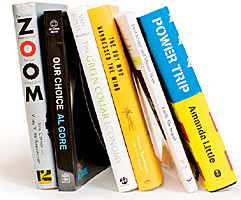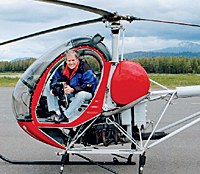sierraclub.org - sierra magazine - march/april 2010 - mixed media


Mixed Media | Deep Thoughts and Oddball Interpretations
The Monkey Wrench Gang | Life in HD | Earth Beat
The Monkey Wrench Gang
Clean-energy thinkers and tinkerers roll up their sleeves
 Humans have been tapping renewable power for millennia: The Chinese built windmills 2,000 years ago to pump water, for instance, and before that the Greeks supposedly zapped enemy ships with beams of sunlight concentrated by curved bronze shields. What's changing today are not just the design and scale of the applications but also the way we talk about them.
Humans have been tapping renewable power for millennia: The Chinese built windmills 2,000 years ago to pump water, for instance, and before that the Greeks supposedly zapped enemy ships with beams of sunlight concentrated by curved bronze shields. What's changing today are not just the design and scale of the applications but also the way we talk about them.
A profusion of recent books, blogs, Web sites, and magazines scrambles to keep up with the clean-energy revolution. Too much of this information adds up to a total snoozefest--wonky and technical, if not cynical and dismissive--but it's hard to think of a topic more urgent, inspiring, and breathtaking. Fortunately, writers, from grassroots innovator William Kamkwamba to megastar Al Gore, are seizing on green technology from all angles, offering hopeful tales of progress, techie chronicles of whiz-bang inventions, and epic manifestos.
Gore's highly anticipated call to arms, Our Choice: A Plan to Solve the Climate Crisis (Rodale, 2009), is a rigorously detailed 400-page inventory of here-and-now solutions to climate change--solar, wind, geothermal, smart-grid components, and carbon capture and sequestration--rich with glossy photos and elegant diagrams. Essentially, it's a sexy textbook, and despite the prevalence of geeky terms like "single-crystal polysilicons" and "gradient zones," I recommend it to anyone who wants a crash course in leading clean-energy technologies and how they work. One caveat: While Our Choice purports to be about hope, it's heavy on doom and gloom: "I am offering you the choice of life or death," reads the opening line, quoting Deuteronomy. "You can choose either blessings or curses."
Consider several more-buoyant books: Earth: the Sequel: The Race to Reinvent Energy and Stop Global Warming (W. W. Norton, 2008), by Environmental Defense Fund president Fred Krupp and Miriam Horn, brims with capitalist fervor as it describes a smorgasbord of green technologies, from the tried-and-true to out-there possibilities like virus-powered batteries and "hairy" solar panels built from nanoparticles. Another celebration of innovation is Zoom: The Global Race to Fuel the Car of the Future (Twelve, 2007), in which Economist writers Vijay V. Vaitheeswaran and Iain Carson explore a "great awakening" in the global auto industry that's propelling advances in clean electric cars.
Turning an eye to people, not gizmos, environmental advocate Van Jones argues in The Green Collar Economy: How One Solution Can Fix Our Biggest Problems (HarperCollins, 2008) that emerging green industries can alleviate poverty and promote social justice. "Will the green wave lift all boats?" challenges Jones. He says that skilled, well-paying jobs in solar and wind installation, home weatherization, electric-car manufacturing, and grid retrofits would improve the health and economy of the low-income communities burdened with most of America's polluting plants and facilities.
No doubt the feel-good clean-energy story of the decade is Kamkwamba's The Boy Who Harnessed the Wind: Creating Currents of Electricity and Hope (HarperCollins, 2009), written with Bryan Mealer. As a young boy in Malawi, Kamkwamba was forced to drop out of school as his family's farm was devastated by drought. Following diagrams in a library book, Kamkwamba built a windmill with materials from a scrap heap, pumping water to his family's crops and prosperity into his community.
 Author Amanda Little welcomes the can-do inventiveness of the green-tech revolution.
Author Amanda Little welcomes the can-do inventiveness of the green-tech revolution.
Numerous blogs track the latest news on thin-film solar cells, superconducting power cables, and lithium-ion batteries. Visit Fortune's passionately geeky
Green Wombat, the gearhead paradise
EcoGizmo, Wired's fetishistic
Autopia, Joseph Romm's policy-minded
Climate Progress, and the wonky but practical industry site
Clean Edge. Having grown up with an engineer grandfather who was forever tinkering in the garage, I love the way these eco-tech blogs have the same gee-whiz backyard-enthusiast inventiveness as Popular Science, but with planetary solutions in mind.
It's also worth following bigger-picture developments in the clean-energy industries on the New York Times blog Green Inc. and the Wall Street Journal Environment page, both required reading for green investors. For color on the activist organizations promoting clean energy, check out the inspired photographs and commentary on 350.org, which aims to make 350 parts per million (the safe upper limit of carbon dioxide in the atmosphere) "the most important number in the world"; Gore's Repower America; the green-collar-jobs advocacy site Green for All; T. Boone Pickens's bold PickensPlan (pickensplan.com); and the plucky-youth climate blog It's Getting Hot in Here.
In the early 1900s, Thomas Edison said in a little-known interview: "The scheme of combustion to get power makes me sick to think of it, it's so wasteful. You see, we should utilize natural forces and thus get all of our power. Sunshine is a form of energy, and the winds and the tides are manifestations of energy. Do we use them? Oh no! We burn up wood and coal, as renters burn up the front fence for fuel. We live like squatters, not as if we owned the property." The father of America's energy industry would be pleased to know that his opinion, rare in his day, has been joined a century later by so many others.
Adapted from Amanda Little's Power Trip: From Oil Wells to Solar Cells--Our Ride to the Renewable Future
(HarperCollins, 2009)
 There I sat at a Desk made of formica (an oil-derived polymer), wearing a sweatshirt made of fleece (also derived from crude) over yoga pants made from Lycra (ditto), sipping coffee shipped from Zimbabwe, eating an apple trucked from Washington, surrounded by walls covered with oil-derived paints, jotting notes in petroleum-derived ink, typing words on a petrochemical keyboard into a computer powered by coal plants. Even the supposedly guilt-free whole-grain cereal I had for breakfast and the veggie burger I ate for lunch came from crops treated with oil-
derived fertilizers.
There I sat at a Desk made of formica (an oil-derived polymer), wearing a sweatshirt made of fleece (also derived from crude) over yoga pants made from Lycra (ditto), sipping coffee shipped from Zimbabwe, eating an apple trucked from Washington, surrounded by walls covered with oil-derived paints, jotting notes in petroleum-derived ink, typing words on a petrochemical keyboard into a computer powered by coal plants. Even the supposedly guilt-free whole-grain cereal I had for breakfast and the veggie burger I ate for lunch came from crops treated with oil-
derived fertilizers.
My purse yielded another trove of specimens: capsules of Extra-Strength Tylenol made from acetaminophen (a substance, like many commercial pain relievers, that is refined from petroleum); glossy magazines and a packet of photographs printed with petrochemicals; mascara, lip balm, eyeliner, and perfume that, like most cosmetics, have key components derived from oil. Once I connected the dots between so many seemingly disparate elements of my life--my car, my clothes, my e-mail, my makeup, my burger, even my health--I saw an energy landscape far more vast and complex than I'd ever imagined. Energy, I realized, is everything.
Life in HD
 Coming straight at you in high definition: a giant elephant shrew...and Oprah too! The minuscule, sure-footed sengi of East Africa, which meticulously maintains a web of well-memorized pathways for high-speed escapes from airborne predators, is one of dozens of critters highlighted in Life, an 11-part miniseries on animal behavior and survival instincts that airs in March on the Discovery Channel. Life, narrated by Oprah Winfrey, is the latest venture of the BBC's Natural History Unit, which produced the acclaimed series Planet Earth in 2006.
Coming straight at you in high definition: a giant elephant shrew...and Oprah too! The minuscule, sure-footed sengi of East Africa, which meticulously maintains a web of well-memorized pathways for high-speed escapes from airborne predators, is one of dozens of critters highlighted in Life, an 11-part miniseries on animal behavior and survival instincts that airs in March on the Discovery Channel. Life, narrated by Oprah Winfrey, is the latest venture of the BBC's Natural History Unit, which produced the acclaimed series Planet Earth in 2006.
Earth Beat: That Shrinking Feeling

Alaska's 20-Mile Glacier in 1938, left, and in 2007, right.
Before-and-after images are just as compelling when it comes to climate change as they are for fashion makeovers. When photojournalist David Arnold stumbled on high-quality pictures of Swiss and Alaskan glaciers taken by mountain-eer Bradford Washburn in the 1930s, he wanted to see whether the sites had changed since Washburn's time. The eye-opening photos are showcased in Double Exposure: Photographing Climate Change, which has been touring museums since 2008, with upcoming shows in Oklahoma City and Norwich, Vermont.
What motivated Washburn?
Washburn was director of the Museum of Science in Boston. In the late 1930s he began taking extraordinary aerial photographs with a 55-pound army surveillance Fairchild camera. It shot 7-by-9-inch negatives. Ansel Adams took the same type of photographs. Why did Washburn bounce around with fuel kegs at 15,000 feet and lean out of the plane chained to the fuselage? He was a perfectionist. He was a scientist and an artist. And he was a mountaineer. In the 1930s, when it was still so dramatic to climb new peaks, he wanted high-quality photo-graphs so he could pick out his routes.
What motivated you to retrace his shots?
I was a Boston Globe reporter for many years and wrote stories that Brad would feed me. In 2005, toward the end of his life, I purchased a photograph of his that I had always loved, an iconic shot of six climbers crossing a ridge on the Doldenhorn in the Alps. I thought, "I wonder what that looks like now? If global warming is real, has it changed?" It took me three seasons to get it. I kept getting weathered out. Even at 11,000 feet there were dynamic changes in the ice. That surprised glaciologists. They didn't expect to see that kind of change at 11,000 feet.
Was it difficult to find Washburn's sites?
He kept thorough flight logs, so I knew the name of the feature, the altitude he shot it at, and the time of day and date. In some cases the changes are so dramatic that it's hard to tell you're looking at the same feature.
What did it feel like to take your first comparison shot?
When the pilot and I came up on the Hugh Miller Glacier in Glacier Bay National Park, there was no glacier. We looked at each other; it was a "Holy s---!" moment. You realize that this is a very different world from the one Washburn saw.
How is this exhibit unique?
My benchmarks are artistic photographs that invite people into the detail. The show walks a line between fine art, science, and advocacy.
What makes a simple pairing of photos so dramatic?
You can't argue with your eyes. You can talk yourself into things when you're trying to make a point. But when you do it with photographs, you don't need to say anything.
What is the exhibit's lesson?
That we underreact to slow change. These photos point out that, in geologic time, these changes aren't slow at all. In fact, the pace of these changes is drastic and recent.
 "What does it look like," David Arnold wondered. So up he went, camera in hand.
"What does it look like," David Arnold wondered. So up he went, camera in hand.Describe one of the most dramatic pairings.
Alaska's Guyot Glacier, which Brad shot in 1938, has retreated 14 miles. It has fractured into two glaciers. Enough ice has melted from the Guyot to provide for all of New York City's water needs for 97 years.
How do you hope people will react to such stark evidence?
The challenge is to try to create a show that doesn't only depict a dismal melting world but also highlights some of the actions we can take. In this exhibit I dared introduce a photo of people standing in line in Boston to get butter during rationing in World War II. They're all smiling. They're all willing to make that sacrifice. The threat was tangible, whereas the threat of global warming is still a generation away.
What's your environmental vice?
I inherited a classic 29-foot motorboat. At cruising speed, it consumes seven and a half gallons an hour. That's outrageous, though as far as motorboats go, it's fairly modest. —interview by Reed McManus
See more photos of glaciers then and now.
This article has been corrected.
Photos, from top: Tamara Reynolds (books and Amanda Little); iStockphoto/elapela (windmill); iStockphoto/diane555 (plug); iStockphoto/sothy (lightbulb); iStockphoto/abu (mouse); iStockphoto/JamesGdesign (swirls); Lori Eanes (Power Trip); Norbert Rottcher/Discovery Channel/BBC (sengi); courtesy of Archives, University of Alaska (1938 glacier); courtesy of David Arnold (2007 glacier)